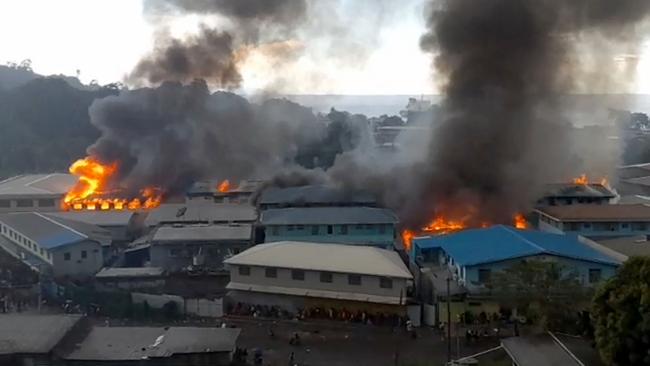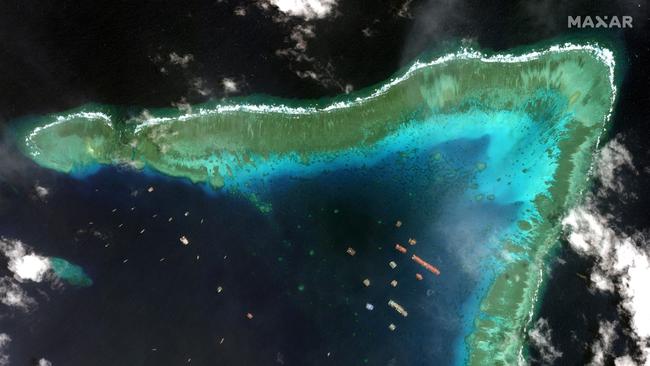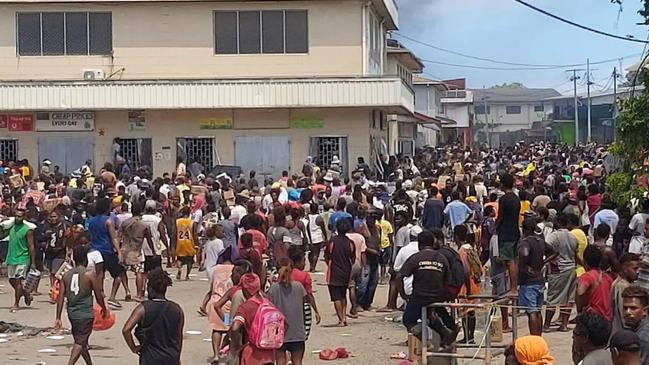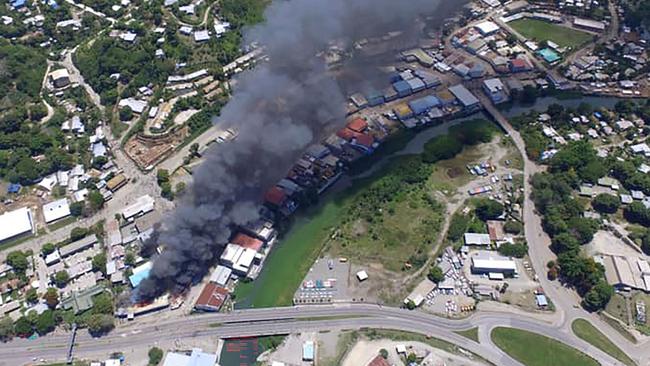This is our backyard, not China’s
China’s ‘magic island-making’ boats are looking for new places to dredge. Now is the time to leverage our AUKUS strength in the Pacific.

Whatever Australia and the US are doing in our Pacific neighbourhood, it isn’t making much impact on China’s rapid expansion in our near abroad.
Last month, nine Pacific government leaders and foreign ministers, and the head of the Pacific Islands Forum, joined China’s foreign minister Wang Yi for a virtual meeting. It inaugurated arrangements to establish a regional centre on development co-operation and another on the impact of climate change on the islands. There was a promise to convene a forum on fisheries co-operation that will take place early next year.
The Kiribati government has just announced it wants to open up the massive Phoenix Island Protected Area, one of the world’s largest marine reserves, to foreign fishing vessels because its fishing revenue has declined in recent years. This will just allow Chinese fishing vessels a larger area to operate to net tuna and revamp China’s interest in developing an airstrip on Kanton Island, the northern most island in the Phoenix group.
The airstrip was built by the US during World War II and is 1600 nautical miles southwest of Hawaii, uncomfortably close to US bases there as well as in Guam.
China has adopted a dual-use approach to building airfields and ports where it seeks strategic locations in the Indo-Pacific to build infrastructure that will later enable Chinese military access.

Plans to pursue a Chinese $10.5bn Daru City project right on our doorstep in Papua New Guinea are still afoot. The Chinese companies backing the project have recently said that they wish to make Daru City the economic hub for PNG with a large seaport and airport.
Daru is the closest PNG community to Australia and very close to the islands of the Torres Strait.
The riots in the Solomon Islands capital Honiara we saw this week have many causes, especially the frustration over influence of Malaysian, Filipino and Chinese loggers and mining companies on the local political process. But they’re also connected to those fighting against the links between China and corruption in the country and the fact that Malaitans, from the most populous province in the Solomon Islands, have been sympathetic to their Premier Daniel Suidani, a man of great courage and principle.
Suidani has been at the centre of some of the strongest resistance to the diplomatic switch from Taiwan to China by Prime Minister Manasseh Sogavare’s government in September 2019.
Suidani enjoys enormous support. There were attempts to bribe him and, when that didn’t work, to threaten him. He has insisted that he wants his province to stay free of China’s influence, pointing out that if you work with authoritarian governments you become more authoritarian.
Partially due to pressure from Beijing, the central government in Honiara has tried to exert more control over Malaita to quell anti-China dissent and gain access to its resources for Chinese companies. Bribes were allegedly paid to Malaitan provincial members in the national parliament to try to topple Suidani. As the highly respected Solomon Islands lawyer and academic Transform Aqorau wrote this week: “Where the money originated from remains a mystery. However, Daniel Suidani’s vocal opposition to the switch to China, and his courting of Taiwan, might give a clue.”

Some of the framing of the fight against China has been faith-based. The 2019 Auki Communique issued by the Malaita provincial government – asserting a process to consider the right to self-determination – specifically mentions rejecting the Chinese Communist Party for, essentially, being systemically atheist.
Given these developments, now is the time to leverage our strengthened alliance co-operation through AUKUS and encourage the US to lift its presence in the South Pacific.
It is focused on Micronesia in the north, leaving Australia to assume the lead in Melanesia and New Zealand in Polynesia. But if a malevolent actor is able to exert control over the northern frontier, that leaves the southern Pacific flank exposed.
Outside of future US use of the naval base at Manus Island, we should support the US to add greater combat power into the South Pacific. This could be through bases or rotational deployments. One argument against adding more US combat weight into Melanesia is that it might tempt China to match or “overmatch” any US efforts.
But at a certain point we are likely to see a Chinese military presence in the region from submarines or Chinese aircraft carriers. That’s why our Jindalee over-the-horizon radar is being extended. At a cost of up to $1bn, it will sweep around from PNG to cover Solomon Islands, Vanuatu and New Caledonia, probably reaching out as far as Fiji. It’s not about spotting fish poachers.
We should encourage the US to expand its diplomatic missions across the region. It’s hard to see the reason why the US lacks embassies in Solomon Islands and Tonga: if you aren’t there, you’re not interested. Australia should work more with the US in Micronesia, the frontline of China’s expansion into the Pacific.
If the US is able to capitalise on Palau’s offer to the US to establish a base, then we should offer some military assets there. We’re now building 12 Offshore Patrol Vessels. There could be a rotational access of say four OPVs through the area. The RAN might operate out of one of the northern islands for nine months a year.

We should be working more with the US on Guam, which is the centrepiece of US-led north Pacific security. It’s also becoming more strategically important for Japan as a military training area.
As China steps up its health support to the island states through deployments of its hospital ship, US and Australian defence forces should deliver health assistance to the islands. This shouldn’t be “drive-by medicine”; we should develop regular rotation of teams of military clinicians through host-nation hospitals for around four weeks each. The allies should share risk assessments on undersea cables with the islands. China is emerging as a major cable provider with potential risks of espionage or industrial sabotage. All Chinese firms are required to co-operate with Beijing’s intelligence and security services.
China’s “magic island-making” boats that have been operating in the South China Sea are looking for new places to dredge. The demand for and high cost of land reclamation projects in the Pacific Islands make such projects another means for Chinese economic coercion. Australia and the US should encourage their engineering firms to assist the islands in land reclamation if they choose this approach. We should prevent China from using sea-level rise as a means of gaining greater influence in the region.

Given the importance of maritime transport and safety in the Pacific and the success of the Pacific patrol boats that Australia has donated to the island countries, the allies should combine to design and construct safe ferries to be operated under the islands’ ownership.
Both countries can assist the Pacific Islands to access space services or to build small satellites through sharing of technology. No satellite has been launched or operated by a Pacific Island state. There are no projects devoted to building the autonomous space capabilities of any island nation. That constrains the islands’ ability to participate in the rapidly growing space economy.
Finally, we should leverage the private sector in our two countries and establish an emerging business leaders program of mentorship and training programs for Pacific entrepreneurs at the best US and Australian university business schools.
Australia and the US must respond to both development challenges and geostrategic competition in the Pacific Islands. We can’t afford the luxury of choosing. The same applies to the islands themselves. From their World War II experience, they know they’d be on the front line if regional great power competition resulted in actual conflict.
Anthony Bergin is a senior fellow at the Australian Strategic Policy Institute.




To join the conversation, please log in. Don't have an account? Register
Join the conversation, you are commenting as Logout